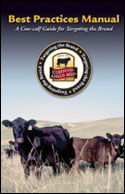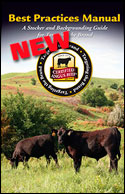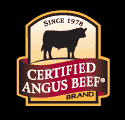Dry Weather Can Lead
to a Lethal Lunch
Nitrate and prussic acid buildup in forages can poison cattle.
Most people don't think of grass as poison, but dry weather and drought can turn a pasture dangerous.
Nitrates and prussic acid built to lethal levels in the stems and leaves of some plants as the hot days of July and August slowed forage growth to a halt. To protect your herd, University of Missouri (MU) Extension experts recommend a simple test to ensure cows aren't chewing their way to disaster.
"Be aware of warm-season annual grasses, especially when fertilized with 50-60 pounds of nitrogen and coming out of very dry weather," said Craig Roberts, an MU Extension forage crops state specialist. "Each of those factors causes the risk to go way up, and if all are present never send cattle in or feed without testing."
Symptoms in livestock and horses can range from heavy breathing, gasping and slobbering to trouble walking, trembling, rapid pulse and death. These symptoms are similar for both nitrate and prussic acid poisoning.
"When there's a drought, warm-season annuals quit growing but still take up nitrogen from the soil and accumulate nitrates and prussic acid," Roberts said. "Once the drought ends those plants start to grow again and look green and lush, but they'll be full of toxins."
When cows eat tainted forages, nitrates convert to nitrites, which absorb into the bloodstream and stop the blood's ability to carry oxygen. Chewing cud creates prussic acid when molecules containing sugar and cyanide in the leaf react with a plant enzyme, freeing up highly poisonous cyanide. Nitrate levels tend to be higher in stems, stalks and young leaves, and prussic acid accumulates more in leaves than stems.
Any plant with the ability to grow quickly can develop buildup, but some forages present a bigger threat than others. The sorghum family — including sorghum-Sudan hybrids, forage sorghum, Sudan grass and Johnsongrass — can develop the most buildup of nitrates and prussic acid. Other small grains, millet, Bermuda grass and tall fescue can also potentially develop harmful nitrate levels in their tissue.
"It's folks who plant warm-season annuals later in the season, such as the summer, that have the biggest problem," Roberts said.
While prussic acid will break down and eliminate itself as a problem in harvested forages, nitrates stay in baled hay and silage. If still standing in the pasture or field, harmful nitrate levels will lessen after a week if rain causes their growth to start again.
Roberts said that if there is any doubt, wait for a test before turning cattle out to graze. Obtain testing kits from your local Extension office. Those kits use sulfuric acid and an indicator dye to detect the presence of nitrates. A prussic acid indicator test is available from commercial laboratories.
"To test for nitrates we typically take the plant, cut its stalk open with a pocketknife, put a few drops of solution on it and if it turns a dark purple color it indicates high nitrate levels," Roberts said. "If that happens you should send a sample to a lab for a quantitative test."
Contact your local MU Extension office for more information on forage testing.
Find out more about nitrates and prussic acid at extension.missouri.edu/p/G4661. A technical explanation of nitrate testing is available at extension.missouri.edu/p/G9811.
Read more about forage testing at extension.missouri.edu/webster/webster/agric/
UnderstandingYourForageTest.pdf.

[Click here to go to the top of the page.]









